Well, fall season is here in America and winter is just around the corner. Having said that for most of us Filipinos here in the U.S. or abroad our bodies are starting to look for something warm to eat to compensate for the cold weather outside. So, of course, what is better to have than a hot bowl of Arroz Caldo.
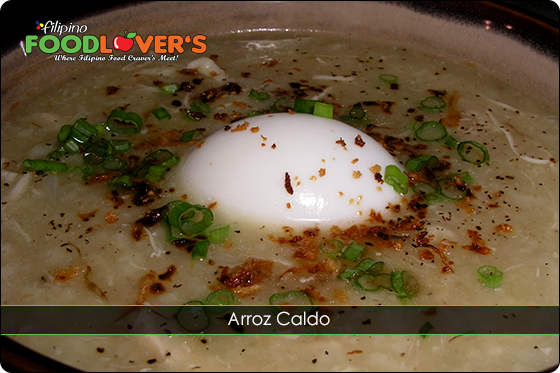
But before we head to the kitchen let’s dig a little bit deeper about this classic dish. Lugaw is the Filipino version of congee. It is very similar to Cantonese style congee, however, lugaw is typically a thicker consistency, retaining the shape of the rice while achieving the same type of texture. It is boiled with fresh ginger. A lot of times it is topped with scallions and served with crispy, fried garlic. Chicken stock is also used to flavor the soup.
In the Philippines they also serve tokwat baboy, (diced tofu and pork) as well as calamansi, and fish sauce. This is often served at the street side eateries commonly known as turo-turo restaurants. This is also very popular among Filipinos living abroad in colder weather because it is warm, soft, and easily digestible.
Now we know how they came up with this soup, so let’s head to the kitchen and cook some Arroz Caldo.
For the stock:
- 1 Whole chicken cut-up into smaller pieces
- 6 Quarts of water
- 1 Onion peeled and thinly sliced
- 1 Tsp. MSG
- 1 Tbs. Salt
For the rice:
- 1½ Cup of long grain rice (jasmine rice)
- 9 Cups of water
For the soup:
- 1 Large ginger peeled and sliced thinly
- 5 Cloves of garlic peeled and smashed
- 10 Cups of chicken stock
- 1½ Tbs. Safflower
- ½ Tbs. Ground black pepper
- ½ Tbs. MSG
- 3 Tbs. Patis (fish sauce)
- 1 Tbs. Salt
- Hard-boiled eggs*
- Fried smashed garlic*
Directions:
Prepare the chicken and the stock; Rinse the chicken very thoroughly and cut it all up into smaller pieces, with the exception of the two breast halves.
- Place chicken cut-up into an 8 quart stock pot with 5 to 6 quarts of water.
- Bring water to a boil and remove scum as it rises.
- Next add the onions and salt. Cover and let it simmer for 1 hour.
- After an hour turn heat off and remove the meat from the pot.
- Place meat on a tray and let it cool off. In a large bowl, using a strainer, pour the stock and strain all the solids that are in the stock.
- Next discard the solids removed from the stock and set the stock aside.
- When chicken is finally cooled off locate one of the breast halves and one chicken thigh, de-bone, and discard the bones.
- Remove the meat from the bone by shredding the meat from the bone and saving the skin.
- Slice chicken skin into small strips and set aside.
- As for the rest of the chicken carcasses, place them in zip lock bags and freeze them to save for later cooking.
The Soup:
- Using the same 8-quart stockpot heat 3 Tbs. of corn oil and saute garlic until golden brown.
- Next add onions and cook until they hit the shiny stage.
- Then add ginger, chicken meat, chicken skins, black pepper, msg, and fish sauce (patis) and let it cook for 3 minutes.
- Add the rice.
- While stirring constantly, let it cook for 2 minutes.
- If the rice has thickened add 2 cups of chicken stock and mix it well.
- Make sure all the lumps are smooth before adding rice to the pot.
- After the 2 minutes add 10 to 12 cups of chicken stock into the pot depending on how thick you want your Arroz Caldo.
- Bring it back to a simmer while mixing it constantly.
- As soon it starts to simmer add the salt, safflower, keep stirring and let it cook over medium low heat for 10 minutes while stirring constantly.
- Finally adjust the taste by adding more salt & pepper if needed.
- Serve hot with hard-boiled eggs and topped with green onion (scallions) and fried smashed garlic.
- Drizzle it with fish sauce and calamansi. Enjoy your mouth-watering Arroz Caldo!
The Rice:
- In a pot add 1½ cups of rice and add 9 cups of water.
- Bring to a boil, lower the heat to medium low, and let it simmer for 45 minutes un-covered.
- Stir the rice frequently to avoid scorching. Set aside.
The Hard-Boiled Eggs: *
- Add eggs into a small pot and cover with water until it’s about half an inch from the top of the eggs.
- Boil for 15 minutes (10 minutes for soft boiled).
- This might sound silly, but you’d be surprised how many people don’t know how to properly cook hard-boiled eggs.
- People say that you should just leave it boiling long enough for it to cook.
- That is somewhat true, but the problem is if you leave it cooking too long you will have a hard time de-shelling the eggs as the membrane between the eggs and the shell will act like glue.
- You will wind up with pretty torn up eggs.
For the Fried Garlic: *
- Peel and smash 8 cloves of garlic.
- Set aside.
- Over medium low heat, heat oil in a small frying pan and add smashed garlic until dark golden brown.
- Transfer the garlic onto a plate lined with paper towels to drain the oil and set aside.
Note 1:
I use safflower for this dish to give it a yellowish hue. That gives it the look you expect from this rice soup.
Note 2:
When making arroz caldo you have to remember that the stock is what gives this soup it’s good flavor. It is very important to have a very good quality stock.
If at all possible make your own stock by using a whole chicken to give it the maximum chicken flavor. Avoid using chicken bouillon or cheap low quality canned chicken stock.
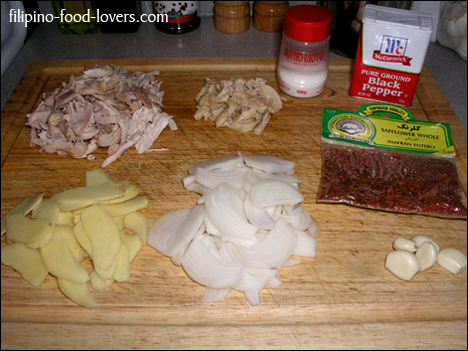
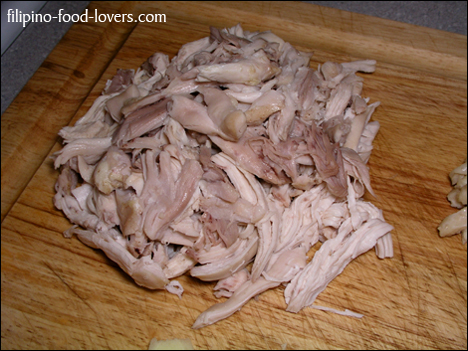
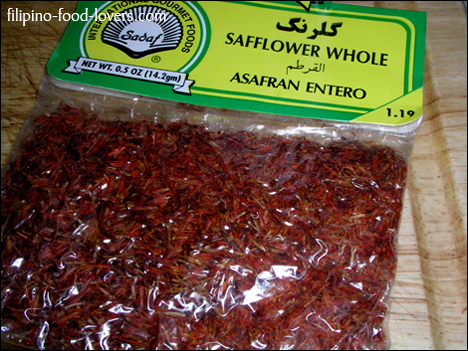
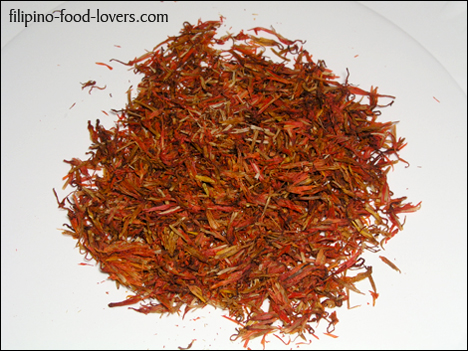
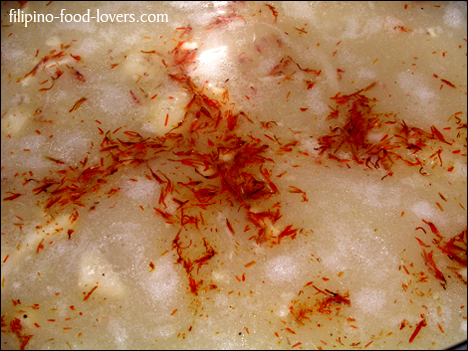
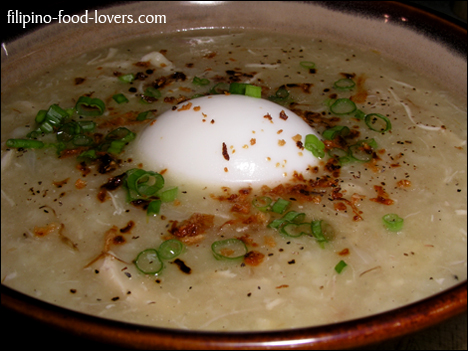
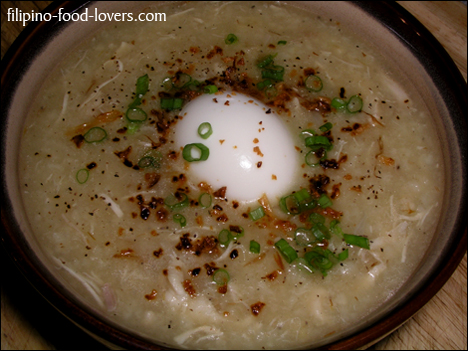
 Posted in
Posted in  Tags:
Tags: 


helo… thank you for sharing your recipes.
Arozcaldo is my favorite.
your website is awesome! The details are extensive. Anybody looking at these recipes will feel very confident in following your recipe.
Excellent job!
AWESOME!!! EXCELLENT POST, VERY DETAILED. MANY THANKS
Excellent recipe with good details! i’m making Lugao right now and thought of looking up some pointers for making this and came across this one! it is one of my favorites along with sinigang ..thing is I never tried using saffron does this ingredient make the soup alot better?? now I know what those little reddish brown pieces are in the soup! I will try using it thanks! 🙂
yummy!!!!
i feel hungry !!!
yumm….yummm,,, uhhmmm i like arroz caldo
OH THANK GAWD FOR YOUR SITE!!!! I ABSOLUTELY LOVE YOUR BLOG! ITS GOT EVERYTHING A GIRL COULD WANT!!! PICTURES, RECIPES, DIRECTIONS THAT ANYONE CAN UNDERSTAND! AND IT COMES CLOSE, SO CLOSE TO WHAT I REMEMBER GROWING UP IN THE PI. Sorry for the caps.. just so HAPPY to find your site!! HAPPY! HAPPY! HAPPY!!! I hope you add more recipes in the future! OH JOY! OH JOY! OH JOY!!! Please add lumpiang shanghai, goto (with pork blood and tripe), Pancit luglog, pancit malabon to name a few. 🙂 ME SO HAPPY!!! THANK YOU! THANK YOU! THANK YOU!!!
hi thanks for this site absolutely brilliant,,well done!and,i like the pictures:)..xx
You’re such a wonderful guy for sharing everything like this… Congrats… I LOVE THIS FOOD.. GOD BLESS YOU!
What a GREAT site!! Your recipe came out SO GOOD! It was my 1st time cooking Arroz Caldo & it tasted pretty close to my Mother-In-Laws… and thats pretty darn good! Thanks for sharing!!!
mmmmm i love arroz caldo!
Goood recipe, I love this site!
Aaaaa. Saraaaaaap…. Just ate arroz caldo…. Tastes so goood…
thanks for the recipe. i’m pregnant and have been craving for the right food that i can eat and congee esp. arroz caldo somehow makes me eat as i always have a problem with my tastebuds lately.
now i can just cook it at home anytime i feel like eating it!!!
joanne 🙂
Looks like a delicious recipe — I can hardly wait to try it out!
I can offer a couple of tips on how to *always* turn out perfectly-cooked hard boiled eggs. This technique works for almost any quantity of eggs, from one to a dozen.
– Put your eggs in an pot that will allow you to cover them with 1″ of water.
– Bring the pot to a boil. As soon as you reach a boil, cover the pot and turn off the heat.
– After 12 minutes, put the pot in the sink and run cold water over the eggs. You could also just drain the pot and add ice and water. This quick-chill will ensure you get bright yellow yolks without any icky gray discoloration.
– Lastly, the biggest things that makes hard boiled eggs difficult to peel has nothing to do with how their cooked. It’s all about the age of the eggs. If you have a choice, use the oldest eggs you’ve got. They will have dehydrated a little bit, and this will pull the membrane away from the shell. If I know I’ll be making hard boiled eggs ahead of time, I buy them a week in advance. It makes a huge difference.
Great web site you’ve got!
thanks for your site and also it helps me to get an idea what to bring for my family get together potluck next time..
I have heard of arroz caldo, but I’ve not eaten it until last February when I flew on Phil Airlines. I make my own version without a lot of starch, by using Minute Rice. yummy
Ummm, just a comment on the saffron. You do not want to use a tablespoon of it in anything. Ever. Even the Indians use only a pinch at a time, mostly. A tablespoon would be prohibitively expensive, like about 30 to 40 dollars American. It has too strong a taste to use that much, even if you could afford to use that much. Last time I purchased a small box, it cost 17 dollars US for 2 grams. Stick with your safflower, if you are only looking for color.
your arroz caldo makes me hungry, yummy
Sage,
Thanks for your comment about the Saffron. As I mentioned on this recipe I have not use it before and therefore didn’t have any idea on how expensive Saffron is. After confirming on how expensive it is I now understand why they don’t hardly use this stuff in our Arroz Caldo in the Philippines. Arroz Caldo is supposed to be cheap and affordable for most people. 🙂
Robert Colinares
Thank you, very detailed and heplful. Its my first time to cook arroz caldo for my husband, we are in SG its usually hot here, but today it is raining so this Filipino soup I trully miss is perfect!
A filipino food… Lugaw is the other name… Sarap, this made me hungry.
My Filipina wife of 43 years just had brain surgery last Thursday to remove a tumor that has just about completely erased her memory. Back in the home of our daughter she is making a remarkable recovery and today without knowing what it was called, asked for lugaw, the first thing she will eat in 9 days.
We brought her into the kitchen in her new wheelchair where our daughter and two grandkids are listening to her try and explain how to make the dish. To ensure that we were on the right track we jumped onto your web site.
She loved the pictures and it made her even more excited to eat. This dish will bring her a flood of memories and I want to thank all of you who have contributed over the years to make this a virtual home away from home.
Comfort is what she needs and your site will help bring the comfort foods she loves so much.
Hi Peter,
I am sorry to hear about your wife I wish her the very best for her quick recovery. I thank you very much for taking the time to share your story and appreciation for this.
Hearing your story and how this site can help the recovery of your wife is priceless for me. Again thank you very much for sharing your story and god bless your wife, you, and your family.
Sincerely,
Robert Colinares
Just a note on the saffron/safflower comments. Recently I discovered safflower being sold in the spice section of our local bulk foods store under the name ‘American saffron.’ I picked some up just to make this dish. It was cheap: 25g for under two dollars, and the lady at the counter said they sold a lot of it, but wasn’t sure what plant it was from. This might contribute to the name confusion…
Hi Lara,
I don’t really know the scientific difference with these two other than their complete different in appearance and the massive difference in price. Saffron is definitely far more expensive than Safflower I guess that’s explain why more people uses Safflower to color their food than Saffron. I buy my Safflower at our Asian groceries store and they are pretty cheap if I remember it correctly I only give $1.99 for 1oz package.
Cheers,
Robert Colinares
Just found your site and can’t wait to go thru it! Thanks for your posts and giving me a taste of home. In regards to the Saffron/Safflower question, most Filipinos use Safflower.
As a foodie & Filipino, I learned the difference between Saffron and Safflower trying to find alternatives in the USA. Saffron is the stigma of the Crocus flower. This has to be hand-picked, which is why the cost is so expensive. Also, it adds a lot of flavor and color so it must be used sparingly (a pinch will go a long way).
Safflower (known in the Philippines as “kasubha”) is commonly mistaken as Saffron because of the same color it produces. It is a flower with a mild flavor and usually found dried. The best way to enhance it’s flavor is to use a dry pan and roast it for a few seconds on the stovetop before using in your recipe. This releases the oils, which in effect results in a similar flavor to Saffron. You can find Safflower in Mexican or Asian grocery stores for around $5 (usually less) – a wonderful and inexpensive alternative to Saffron. By comparison, a $2 bag of Safflower = $20+ bottle of Saffron with same amount of flavor & color.
Hope this helps! Keep up the good work. Mabuhay!
Hi Robert!
I’m new to the site but loving it – good job! Here’s a bit of clarification on the saffron/safflower issue.
Saffron is the stamen of the crocus flower. This is hand-picked, thus resulting in a much higher cost (most expensive spice per pound I believe).
Safflower is a flower that goes by the same name, usually purchased dried and with a mild flavor. The best way to enhance or bring out the flavor of the safflower is to roast it for a few seconds over a dry (preferably non-stick) pan. Safflower is inexpensive but provides a nice flavor & color similar to saffron and a traditional accompaniment to Arroz Caldo.
Hope this helps 🙂
Dexter
Hi Robert…I could not track the discussion on the use of saffron and safflower in your website. I use saffron (only a PINCH) when I cook any soup. I’m sure when used in your Arroz Caldo recipe, the addition of saffron (stigma of a crocus plant mostly from Spain) will make it really palatable. So far, the cheapest saffron spice I find in the market is Trader Joes.
Tip: This works everytime. Boil eggs up until water reaches the boiling point then turn heat off right away but leave the eggs for 9 minutes then take them out. Cooks perfectly and easy to peel. Hope it helps. Can’t wait to try this recipe. Looks goood!
Hi Lara and Robert,
This is the first time I saw this website and saw how to make tinapa and got interested. My mother in law use to make tinapang bangus but never I was really serious of asking her the recipe. When she died I regret not asking her of different recipes I like.
I know the difference between safflower and saffron. Saffron is the most expensive spice sold. It is mostly used for rice recipes like paella. It is a yellow orange stigma from a small purple crocus. you only use a few small strands of stigmas. The flavor is a lot better when you used it in recipes and safflower is normally called bastard or thistle saffron a lower quality spice and need to use a lot but can distinguished the taste difference between the two. If you only want the color you can use a very small amount of atchuete or bijole condiments. Hope this will help you. Bon Appetit
thanks for the effort …..God bless and more power to you.. love you all guys muahhhhhhhhhhhhhhh
Excellent recipe! My wife is sick and she loves Lugaw, so I made her some last night using your recipe. It was off the hook, her and the kids absolutely loved it.
Thanks for the help Bro 🙂
You’re welcome Justin, I am glad that your family liked it and I hope your wife gets to feeling better soon!
Cheers,
Robert Colinares
more videos pls
It’s coming. 🙂
WOW!, my favorite Arroz Caldo. Thanks for the recipe. yum yum yum!
where can i buy dried safflower in philippines?